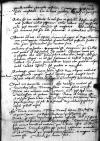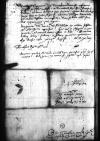Gratae mihi fuerunt ⌊⌋ Reverendissimae Dominationis Vestrae, quibus et humanissime mihi rescripsit, et me in album suorum benigne recepit. Qua tanta illius humanitate meaque ista felicitate vehementer sum delectatus. Mei officii erit eum praestare me, qui benevolentia gratiaque Dominationis Vestrae Reverendissimae non ingratus aut indignus iudicer.
Hortatu domini ⌊Mauritii⌋ abitionem ⌊hinc⌋ adornantis submonui ⌊reginam⌋ dominam meam, num vellet Reverendissimae Dominationi Vestrae aliquid ad eius ⌊⌋ respondere. ⌊Maiestas sua⌋ pauxillum illud de negotio matrimoniali ⌊⌋ iussit. In quo quid aliud causae sit, non satis perspicio, nisi quod ⌊illa⌋ in negotiis eiuscemodi secretior esse vult et ea ab oculis nostris abscondit. Nec reverendissimus ⌊dominus Plocensis⌋ credita haec sibi habet.
⌊Rex noster⌋ grandaevus senex iam, Deo sit gratia, magis in dies ac magis convalescit. ⌊Rex filius⌋, ⌊ambae reginae⌋ recte valent, sed viduis similes sunt, quandoquidem solacio maritorum destitutae videntur, nam ⌊alter⌋ senex est, alter voluntarie puer, vel potius castae vitae amator. Certe mira continentia est ⌊princeps⌋ hic noster, quod ego ex intimis eius mihi quam amicissimis exploratum habeo. Decrevit adhuc aliquanto tempore a re uxoria abstinere, eo fortasse consilio, donec ⌊uxor regina⌋ et ⌊ille⌋ una maturiores sint et aetate corrob<or>atiores ad firmam prolem producendam. Nec id fit, ut plerique existimant, odio ⌊reginae⌋ tam pulcherrimae ac sanctissimae, quam omnes benedicunt, quam et ipse ⌊rex maritus⌋ magnifacit. Quodsi quis ⌊illum⌋, ut ne haec solacia cum ⌊coniuge sua⌋ differat, cohortetur, respondere solet: “Scio - inquit - debitum officiumque meum, sed quod facio, bona fit ratione.” Quod ipsum sic nonnulli  BCz, 247, p. 389 interpretantur, quod ⌊ille⌋ hac ratione ⌊Ducatum Lituaniae⌋ a ⌊rege patre⌋ facilius se obtinere posse existimet, nam id dixisse hidden by binding⌈[e]e hidden by binding⌉ auditus est: “Pudet - inquit - ⌊me⌋ mei et hominum. ⌊Rex⌋ sum et dux, sed sine regno et sine ducali potestate, non habens certam sedem, ubi cum ⌊regina uxore⌋ considam.” Aiunt et sperant non pauci hidden by binding⌈[i]i hidden by binding⌉ datum iri ⌊illi⌋ a ⌊patre⌋ ⌊Ducatum Lituanicum⌋ idque antequam ⌊hinc⌋ pater rex discedat. Id, quod ⌊populus Lituanicus⌋ universus votis omnibus expetit, nam ⌊eo⌋ dominante omnia optima sperant. Maiore mihi iudicio in rebus omnibus quam pro aetate praeditus esse videtur. Et ingenio promptus est, et amans iustitiae, et summam aequitatem in rebus discernendis adhibet, et prudenter omnia loquitur, et festine etiam, ubi res exigit, et in omnibus rebus factisque divinae se semper hidden by binding⌈[r]r hidden by binding⌉ gratiae commendat. Habebimus ⌊illum⌋, Domino Deo favente hidden by binding⌈[te]te hidden by binding⌉, bonum, iustum et sapientem regem.
BCz, 247, p. 389 interpretantur, quod ⌊ille⌋ hac ratione ⌊Ducatum Lituaniae⌋ a ⌊rege patre⌋ facilius se obtinere posse existimet, nam id dixisse hidden by binding⌈[e]e hidden by binding⌉ auditus est: “Pudet - inquit - ⌊me⌋ mei et hominum. ⌊Rex⌋ sum et dux, sed sine regno et sine ducali potestate, non habens certam sedem, ubi cum ⌊regina uxore⌋ considam.” Aiunt et sperant non pauci hidden by binding⌈[i]i hidden by binding⌉ datum iri ⌊illi⌋ a ⌊patre⌋ ⌊Ducatum Lituanicum⌋ idque antequam ⌊hinc⌋ pater rex discedat. Id, quod ⌊populus Lituanicus⌋ universus votis omnibus expetit, nam ⌊eo⌋ dominante omnia optima sperant. Maiore mihi iudicio in rebus omnibus quam pro aetate praeditus esse videtur. Et ingenio promptus est, et amans iustitiae, et summam aequitatem in rebus discernendis adhibet, et prudenter omnia loquitur, et festine etiam, ubi res exigit, et in omnibus rebus factisque divinae se semper hidden by binding⌈[r]r hidden by binding⌉ gratiae commendat. Habebimus ⌊illum⌋, Domino Deo favente hidden by binding⌈[te]te hidden by binding⌉, bonum, iustum et sapientem regem.
Honores ac magistratus publici ⌊huius dominii⌋ cancellariatus hidden by binding⌈[tus]tus hidden by binding⌉, campiductoratus, marssalcatus, Trocensis item et Podlassiensis hidden by binding⌈[iensis]iensis hidden by binding⌉ palatinatus et castellanatus bini, quae sunt hic primariae dignitates iam diu vacantes, non sunt adhuc distributi. Et ob id reliqui consiliarii, quod non est plenus senatorum numerus, consultationes publicas, ad quas sunt convocati, inceptare nolunt. Orant novos creari magistratus, ut, qu[...] hidden by binding⌈[...][...] hidden by binding⌉ de rebus gravibus consultandum est, opus esse vident(?), ut pleno senatu de rebus tantis statuatur. Cur autem distributio haec honorum differatur, causam veram nescimus, quamvis varii varias comminiscantur. Sed revera pauci sunt ⌊hic hidden by binding⌈[ic]ic hidden by binding⌉⌋ tam amplis digni honoribus. Ingens siquidem est turba, homines pauci.
Reverendissimus ⌊dominus noster Plocensis⌋, qua prudentia hidden by binding⌈[ia]ia hidden by binding⌉ est studioque erga bonum publicum, publice hortatus est illos hidden by binding⌈[s]s hidden by binding⌉, qui nunc sunt senatores, oratione diserta, ut ⌊Poloniae Regno⌋ de se ipso et una de ⌊Lituania⌋ conservanda sollicito ipsi quoque ⌊Lituani⌋ sociis amicisque et sibi ipsis ne desint, cum iam hostis instet supra caput omnium. Spes est, quod ⌊rex senex⌋, sumptis  BCz, 247, p. 391 paulo viribus, graviter consulet et omnia, quae opus sunt, bene constituet. Cui Dominus Deus auxilium dexterae suae porrigat.
BCz, 247, p. 391 paulo viribus, graviter consulet et omnia, quae opus sunt, bene constituet. Cui Dominus Deus auxilium dexterae suae porrigat.
Rebus ⌊hic⌋ non constitutis, de nostro hinc in ⌊Poloniam⌋ discessu nihil certi polliceri nobis possumus. Alii credunt post 1544-09-29⌊Michaelis1544-09-29⌋, alii post 1544-11-11⌊Martini1544-11-11⌋ nos ⌊hinc⌋ esse recessuros. Sed invitissimi ⌊hic⌋ manemus sub hoc caelo Saturnino et incommoditate rerum omnium.
Adventat ad nos ⌊orator⌋ ⌊caesaris⌋ et cum eo ⌊Langus⌋ orator ⌊regis Romanorum⌋ cum quadraginta comitibus, hominibus non postremae sortis. Intra hanc hebdomadam ⌊huc⌋ venturi sunt.
Allatum est ex ⌊Italia⌋ expugnatam esse ⌊Carignanum⌋ per ⌊Gallos⌋ vel potius ad deditionem esse coactam. Caesariani omnes, qui in praesidio ⌊illic⌋ erant, salvi, salvis rebus eorum, dimissi, sed hac sponsione obligati, ne ad sex septimanas in castris ⌊caesaris⌋ militent. In famem, quam tolerare diutius non poterant, culpam traditae ⌊civitatis⌋ conferunt, sed proditio revera fuit.
⌊Barbarossa⌋ gravi damno ⌊Italiam⌋ affecit, nam aliquot civitates [...]...o Senen(si) on the margin⌈[...] hidden by binding⌈[...][...] hidden by binding⌉... illegible⌈...... illegible⌉o Senen(si)[...]...o Senen(si) on the margin⌉ expugnavit, exussit, praedam ingentem cepit, amissis tamen de suis aliquot centis etc. ⌊Papa⌋ cum ⌊Columnensibus⌋ tumultuatur.
Apud nos tranquilla omnia. Ex ⌊Valachia⌋ nuntiatum est ⌊voievodam⌋ illum Turcicam fidem et cum filiis recepisse. ⌊Filium⌋ eius maiorem natu ex ⌊Turcia⌋ nunc post tres annos in ⌊Valachiam⌋ ad ⌊patrem⌋ rediisse, patrem id laetatum esse et in signum huius laetitiae unum ex consiliariis suis, virum bonum populo gratum, sed sibi de affectato voyewodatu suspectum, capite plecti iussit.
Ex ⌊Turcia⌋ nuntiatur filium ⌊Turcorum caesaris⌋ ⌊Mustaffam⌋ ex prima ⌊uxore⌋ per ⌊regem Persarum⌋ profligatum esse. Deinde, quod regnum imperiumque paternum affectasse ⌊illum⌋ sit suspicio, vocatum ad ⌊patrem⌋ venire contemp{i}sisse, conciliare nunc sibi animos multarum nationum, quae a patre caesare ad illum desciscunt, cum quibus filius ipse patrem opprimere contendit et ob id ⌊Turcos⌋, qui partes patris sequuntur, in magno nunc maerore esse. Utinam haec vera sint.
 BCz, 247, p. 392
BCz, 247, p. 392
Mercatores Camenecenses ex ⌊Turcia⌋ domum reversi referunt passim se illic audisse et ⌊Turcos⌋ eis dixisse: “O miseri ⌊Poloni⌋, ad breve tempus pace fruimini. Quam diu vobis ⌊senex rex⌋ in vita superest, interitum vestrum ne timueritis. Qui vobis differtur, non aufertur, nam, sublato vestro ⌊sene⌋, ⌊vos⌋ opprimemini sine negotio.”
Hungarica etiam nova ita superinscribed⌈itaita superinscribed⌉, uti sunt allata, ex altera scheda Dominatio Vestra Reverendissima cognoscet.
Cui me et obsequia mea parata ad omnes nutus offero et dedo. Et valere illam laetam, salvam et felicem ex animo precor.
 BCz, 247, p. 389 interpretantur, quod
BCz, 247, p. 389 interpretantur, quod  BCz, 247, p. 391 paulo viribus, graviter consulet et omnia, quae opus sunt, bene constituet. Cui Dominus Deus auxilium dexterae suae porrigat.
BCz, 247, p. 391 paulo viribus, graviter consulet et omnia, quae opus sunt, bene constituet. Cui Dominus Deus auxilium dexterae suae porrigat.


